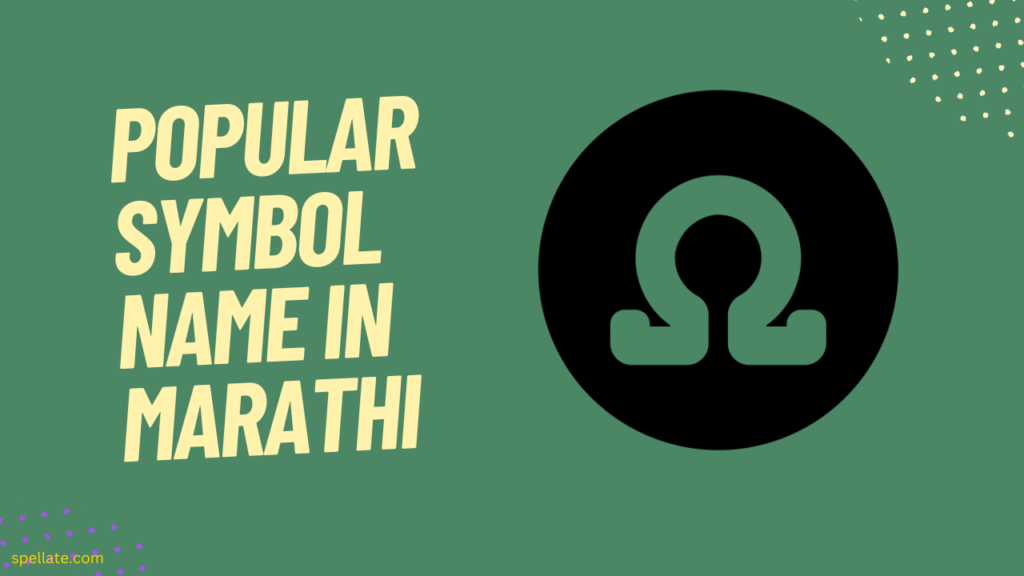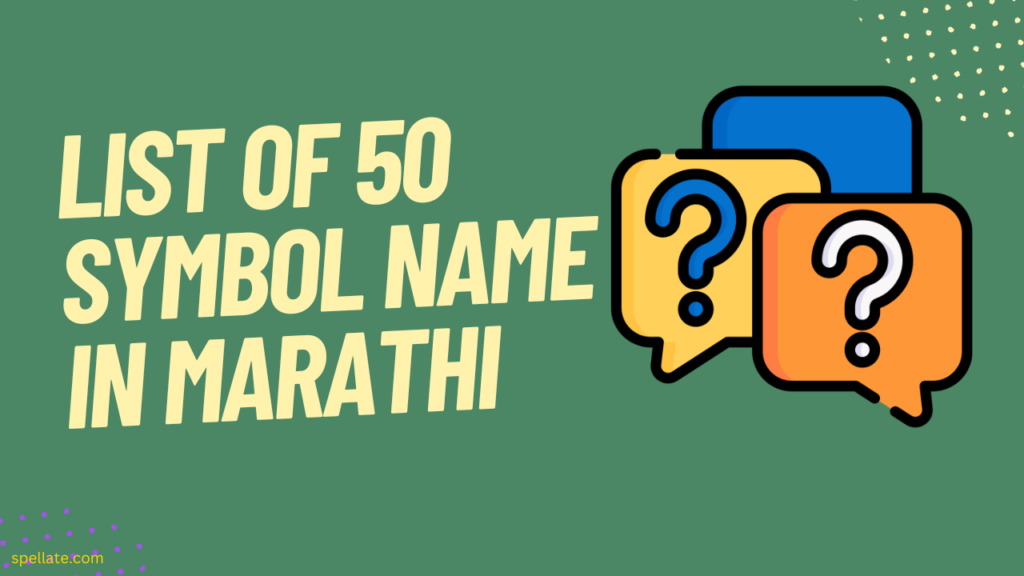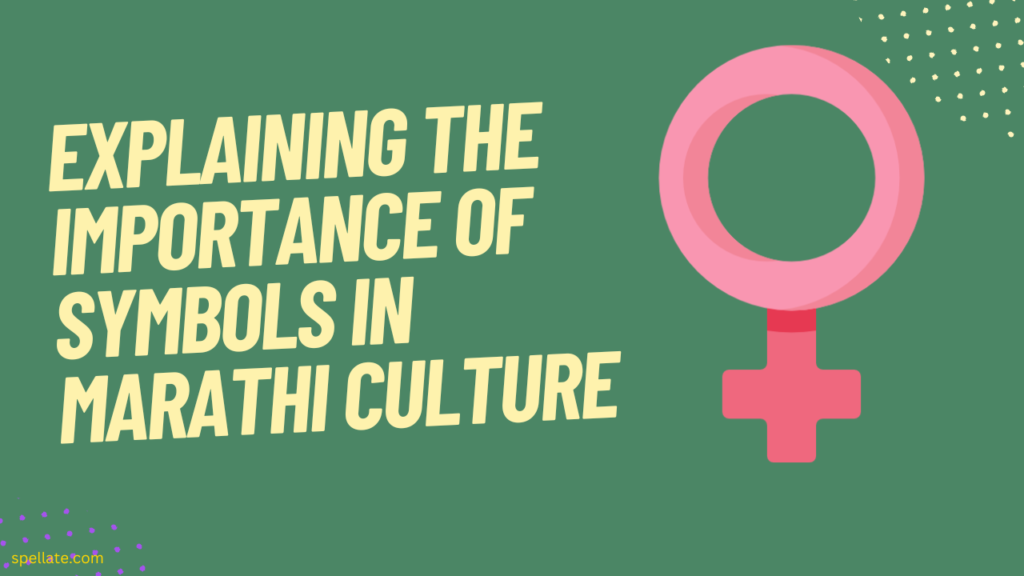Marathi, one of the prominent languages spoken in the western state of Maharashtra in India, is rich in its cultural heritage. From literature to art, Marathi has an extensive vocabulary that encapsulates the essence of Maharashtra’s traditions, beliefs, and way of life. A vital aspect of this language lies in its use of symbols, which play a crucial role in conveying deep-rooted meanings and cultural nuances.
Symbol name in Marathi hold a profound significance in Marathi culture, acting as visual representations of various concepts, ideas, and emotions. They have the power to evoke strong emotions and forge a sense of unity among the people. Whether it’s a religious symbol adorning a place of worship or a symbol used in daily life, each carries a distinctive meaning and connects individuals to their heritage.
In this exploration, we delve into the world of Marathi symbols, uncovering their names, origins, and the stories they tell. From the iconic “Om” symbol, representing the eternal sound of the universe, to the “Shankha” symbolizing purity and spirituality, each symbol has its own tale to tell. We will also encounter symbols associated with festivals, folklore, and traditional practices that have been passed down through generations.
Popular Symbol Name in Marathi

Marathi language, deeply rooted in the vibrant culture of Maharashtra, encompasses a plethora of symbols that hold immense popularity and significance. These symbols, with their unique names, have become iconic representations of Marathi identity, tradition, and beliefs. Let us explore some of the popular symbol names in Marathi that have captured the hearts and imagination of the Marathi-speaking community:
1. ओं (Om):
The symbol “Om” holds immense significance in Hinduism and is considered one of the most sacred symbols in the religion. It represents the eternal sound of the universe and is believed to encompass the essence of all creation, existence, and knowledge. The symbol consists of three curves (resembling the number 3) along with a semicircle and a dot.
Each element of the symbol represents a fundamental aspect of existence – the three curves signify the states of waking, dreaming, and deep sleep, the semicircle represents illusion and the dot represents the transcendental state of pure consciousness. Chanting or meditating on the sound of “Om” is believed to bring spiritual enlightenment, peace, and harmony.
2. शंख (Shankha):
The “Shankha” is a conch shell and is regarded as a sacred symbol in Hinduism. It holds cultural and religious significance and is often used in various rituals, ceremonies, and religious practices. The Shankha is considered auspicious and is blown during religious ceremonies and worship to invoke the presence of deities. It is also believed to purify the surroundings and create positive vibrations. The Shankha symbolizes purity and divinity, and the sound it produces is believed to resonate with the primordial sound of creation.
3. स्वस्तिक (Swastika):
The “Swastika” is an ancient symbol that holds diverse meanings across different cultures. In Marathi, the Swastika symbolizes prosperity, good luck, and well-being. It is characterized by a cross with arms bent at right angles, forming a square pattern. The Swastika has been used in Indian culture for thousands of years and is considered highly auspicious. It is often depicted in religious ceremonies, festivals, and is used as a symbol of protection and blessings. It represents the eternal cycle of life, divine energy, and the four directions.
4. तिरंगा (Tiranga):
The symbol “Tiranga” refers to the Indian national flag. It is a tricolor flag that holds great pride and significance for the people of India. The flag consists of three horizontal stripes of equal width. The topmost saffron stripe represents courage and sacrifice, the middle white stripe signifies peace and truth, and the bottom green stripe symbolizes fertility and prosperity. In the center of the white stripe, there is the Ashoka Chakra, a wheel with 24 spokes, which represents progress, righteousness, and the continuous cycle of life. The Tiranga is a symbol of unity, diversity, and the independence of India, and it is revered as a national emblem.
5. घंटा (Ghanta):
The “Ghanta” refers to a bell in Marathi. It holds cultural and religious significance in various traditions and rituals. The Ghanta is usually made of metal and has a distinctive sound when rung. It is commonly used in temples and other religious places during prayers and ceremonies. The sound of the Ghanta is believed to ward off negative energies, invoke the presence of deities, and create a sacred atmosphere. It serves as a symbol of devotion, spirituality, and the connection between the physical and divine realms. The ringing of the Ghanta signifies the beginning or conclusion of religious rituals and is considered an auspicious and purifying act.
6. (Path):
The term “पंथ” (Path) in Marathi refers to the spiritual path or the way of life one follows. It encompasses the various philosophies, beliefs, and practices that guide individuals on their spiritual journey. The concept of पंथ acknowledges that there are multiple paths or approaches to attaining spiritual enlightenment and self-realization. These paths can include Bhakti (devotion), Karma (action), Jnana (knowledge), and other disciplines.
Each path offers a unique perspective and set of practices to help individuals deepen their understanding of themselves, the world, and the divine. पंथ emphasizes the importance of personal exploration and the freedom to choose a spiritual path that resonates with one’s beliefs and aspirations.
You May Also Like
7. श्री (Shree):
The term “श्री” (Shree) is a revered title or honorific used as a prefix in Marathi. It is added before names or titles to denote respect, auspiciousness, and prosperity. “श्री” is often used to address or refer to individuals who hold esteemed positions, such as scholars, religious figures, and dignitaries. It is also associated with the goddess Lakshmi, the Hindu deity of wealth, fortune, and abundance.
By adding “श्री” before a name, it signifies reverence and is considered a gesture of honor. The usage of “श्री” reflects the cultural value of showing respect and acknowledging the auspiciousness associated with certain individuals or entities.
List of 50 Symbol name in marathi

Marathi is a regional language spoken in the Indian state of Maharashtra. The script used to write Marathi is called Devanagari, which is also used for Hindi and Sanskrit. One of the interesting aspects of Marathi culture is the use of symbols and their significance in daily life. Here’s a list of 50 symbol names in Marathi that you might find interesting:
| No | Symbol Name in Marathi | English Translation |
| 1 | ओं | Om |
| 2 | शंख | Shankha |
| 3 | स्वस्तिक | Swastika |
| 4 | तिरंगा | Tiranga |
| 5 | घंटा | Ghanta |
| 6 | पंथ | Path |
| 7 | श्री | Shree |
| 8 | तिळा | Tilaka |
| 9 | कुंकुम | Kumkum |
| 10 | चंदन | Chandan |
| 11 | मंगलसूत्र | Mangalsutra |
| 12 | नाथ | Nath |
| 13 | कर्णफूल | Karnaphool |
| 14 | बिंदी | Bindi |
| 15 | अशोकस्तंभ | Ashoka Stambha |
| 16 | पादुका | Paduka |
| 17 | दीप | Deep |
| 18 | श्वेत चदण | Shwet Chandan |
| 19 | पूजा थाली | Puja Thali |
| 20 | वरमाला | Varmala |
| 21 | धर्मचक्र | Dharma Chakra |
| 22 | यज्ञोपवीत | Yajnopavit |
| 23 | तांबडी पत्र | Tambadi Patra |
| 24 | शुभलग्न चिन्ह | Shubh-Lagna Chinha |
| 25 | वैष्णव तिलक | Vaishnav Tilak |
| 26 | सुपारी | Supari |
| 27 | पारंपरिक गणपती वेलंट | Traditional Ganpati Welant |
| 28 | वीणा | Veena |
| 29 | खडग | Khadag |
| 30 | पुष्प | Pushp |
| 31 | मांडव्या | Mandavya |
| 32 | कंठी | Kanthi |
| 33 | विभूषण | Vibhushan |
| 34 | तुलसी माळ | Tulsi Mala |
| 35 | बांधनी | Bandhani |
| 36 | लक्ष्मी पाडका | Lakshmi Padaka |
| 37 | गणेश यंत्र | Ganesh Yantra |
| 38 | पात्र | Patra |
| 39 | सुरपाण | Surpan |
| 40 | चंद्रकोर | Chandrakor |
| 41 | रथ | Rath |
| 42 | सिंह ध्वज | Singh Dhwaja |
| 43 | मत्स्य | Matsya |
| 44 | वादन | Vadan |
| 45 | बन्नी | Banni |
| 46 | पर्ण | Parn |
| 47 | अर्पणी | Arpani |
| 48 | महामण्डल | Mahamandal |
| 49 | अर्धचंद्र | Ardhachandra |
| 50 | धातूचे मूद्रन | Dhatuche Mudra |
| 51 | पौराणिक वेगवेलंट | Mythological Vegvelant |
| 52 | पार्थिवी | Parthivi |
| 53 | शिरस्त्राण | Shirastrana |
| 54 | ज्ञान मुद्रा | Gyan Mudra |
| 55 | पर्वत | Parvat |
Explaining the importance of symbols in Marathi culture

Symbols play a significant role in Marathi culture, serving as powerful vehicles for expressing ideas, beliefs, and cultural identity. They are integral to communication, art, religious practices, and everyday life. Here are some key reasons why symbols hold importance in Marathi culture:
1. Cultural Identity:
Symbols serve as visual representations of Marathi culture and heritage. They embody the values, traditions, and historical significance of the community, fostering a sense of belonging and pride. Whether it’s the use of specific patterns, motifs, or imagery, symbols provide a distinct visual language that identifies Marathi culture and sets it apart.
2. Religious and Spiritual Significance:
Marathi culture is deeply rooted in spirituality and religious practices. Symbols play a vital role in representing deities, rituals, and philosophical concepts. For example, the Om symbol (ॐ) represents the essence of the universe and is regarded as a sacred sound in Hinduism. Similarly, the Swastika symbol (स्वस्तिक) holds religious significance and is associated with auspiciousness and well-being.
3. Artistic Expression:
Marathi culture has a rich artistic tradition, and symbols are often incorporated into various art forms. Whether it’s painting, sculpture, or decorative arts, symbols add depth and meaning to the artistic creations. Traditional patterns like the lotus (कमळ) or the Ashoka Chakra (अशोक चक्र) are frequently depicted in Marathi art, reflecting cultural themes and aesthetics.
4. Social and Ritualistic Practices:
Symbols are an integral part of social and ritualistic practices in Marathi culture. They are used in ceremonies, festivals, and rites of passage. For example, during weddings, intricate mehndi (henna) designs are applied to the bride’s hands, incorporating symbolic elements like peacocks, flowers, or religious symbols. These symbols represent blessings, fertility, and prosperity.
5. Communication and Expression:
Symbols provide a means of non-verbal communication and expression in Marathi culture. They can convey complex ideas, emotions, and messages without the need for extensive explanations. Symbolic gestures, hand signs, or traditional patterns communicate shared meanings, fostering a sense of unity and understanding among community members.
6. Historical and Political Significance:
Symbols often carry historical and political connotations in Marathi culture. They can represent past struggles, achievements, and aspirations. The Ashoka Chakra (अशोक चक्र), a prominent symbol in the Indian national flag, represents the ideas of dharma and progress and has historical significance in the fight for independence.
Final Thoughts
In conclusion, the diverse range of symbol names in Marathi reflects the rich cultural and spiritual heritage of Maharashtra. These symbols hold deep significance and are woven into the fabric of Marathi traditions, beliefs, and practices. From the sacred “Om” representing cosmic energy to the auspicious “Swastika” symbolizing prosperity, each symbol carries a unique meaning and plays a vital role in Marathi culture.
Popular symbol names such as “Tiranga,” “Ghanta,” “Path,” and “Shree” hold a special place in the hearts of Marathi-speaking people, representing national pride, devotion, spiritual paths, and respect. Understanding and embracing these symbol names not only fosters a deeper connection to Marathi culture but also encourages the preservation and celebration of the rich heritage of Maharashtra. These symbols continue to inspire, guide, and unite the Marathi community, serving as a reminder of their cultural identity and values.
FAQs
Are there any symbols in Marathi that are specific to certain festivals or occasions?
Yes, Marathi culture has symbols that are specific to certain festivals or occasions. For example, during Ganesh Chaturthi, the Ganpati murti (Ganesha idol) is a prominent symbol. Similarly, during Diwali, the Rangoli (colorful floor art) and Diya (lamp) are widely used symbols.
What is the full stop symbol in Marathi?
The full stop symbol in Marathi is called “पूर्ण विराम” (Purna Viram). It is used to indicate the end of a sentence or a complete thought.
What are the punctuation marks in Marathi?
In Marathi grammar, the following punctuation marks are commonly used:
- पूर्ण विराम (Purna Viram) – Full Stop
- आवाक्य विराम (Avakya Viram) – Comma
- विसर्ग (Visarg) – Colon
- विसर्जन चिन्ह (Visarjan Chinh) – Exclamation Mark
- प्रश्न चिन्ह (Prashn Chinh) – Question Mark
- विरामचिन्ह (Viram Chinh) – Dash
- विस्मयादिबोधक चिन्ह (Vismayadibodhak Chinh) – Ellipsis
